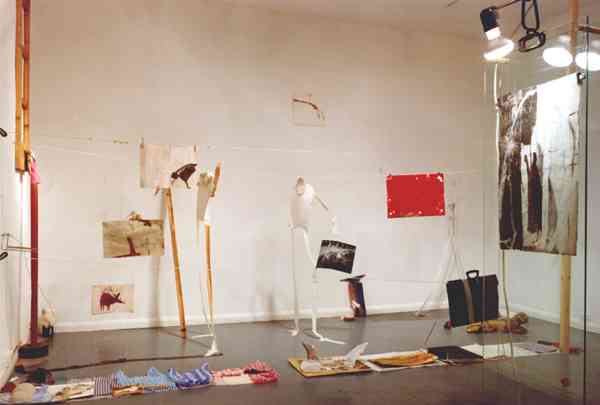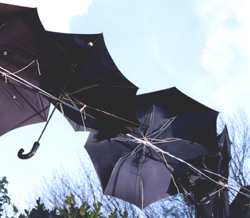| Visual Arts | U.K. | ||||||||||||||||||||||||||||||||||||||||||||||
BAFA © 2010. All material here is copyrighted. See conditions above. |
Karnik
visual artist, U.K.
|
|
Gallery as Tabula Rasa
Review of a site specific installation by Karnik at the Cafe Gallery, London, U.K.
|

Detail of the site specific installation,
Tabula Rasa by Karnik, Cafe Gallery, London, U.K. 1998. (The shadowy figure is Karnik) |
||||||||||||||||||||||||||||||||||||||||||||||||||||||||||||||||||||||||||||||||||||||||||||||||||||||||||||||||||||||||||

|
pull of the city
and points of view detail of Tabula Rasa, installation by Karnik in Cafe Gallery, London, U.K. | ||||||||||||||||||||||||||||||||||||||||||||||||||||||||||||||||||||||||||||||||||||||||||||||||||
Karnik has made a series of highly charged, playful, interconnected site specific works. Debris, ephemera, leftovers, scraps and scrapings, dirt and pigment, carrier bags and cheap paper, have been installed in the gallery space in various guises. Striding paper figures, bird forms, dogs, shadows, ropes and lines range through the space. Karnik's work readily makes visible the physical act of drawing, of inscribing and carving lines, of cutting or tearing, of making pigment and paper malleable. Drawings originate from marks made by stain or blot, or use wire or tape to describe lines in space. In improvising from materials ready to hand, or transforming found materials, the artist suggests the process is akin to the mental act of sifting through stores of information, drawing upon the conscious and unconscious alike. In spite of what the chosen materials may suggest, the process operates far more by design than by accident. Each work in the exhibition connects, both to site and to each other, juxtaposition and coincidence is carefully contrived to make an ensemble. | |||||||||||||||||||||||||||||||||||||||||||||||||||||||||||||||||||||||||||||||||||||||||||||||||||
In 'parking area': a pair of truncated parking meters on a plinth is attached by rope to a drawing stuck on a low trolley. The drawing represents a dark, splatter shaped beast in whose extended paw there is a fly swatter. A place to abandon, punish or simply park up your pet in the city, perhaps? |

Just in case
detail of Tabula Rasa, installation by Karnik in Cafe Gallery, London, U.K. | ||||||||||||||||||||||||||||||||||||||||||||||||||||||||||||||||||||||||||||||||||||||||||||||||||

Cage in search of a bird
detail of Tabula Rasa, installation by Karnik in Cafe Gallery, London, U.K. |
| ||||||||||||||||||||||||||||||||||||||||||||||||||||||||||||||||||||||||||||||||||||||||||||||||||
The observer can move through and around the work, and also touch. The visitor becomes an investigator. A discretely placed spy hole cut through a partition wall gives a round view onto 'the pull of the city'. 'The pull of the city' is peopled by figures made from dress shirt fronts, yellowed and glazed from years of starching. Slender, paper tape legs anchor the figures to the floor some hold onto paper or line. Balanced with humour, there is a mournful undertow present here which seems to connect with the idea of the city as a place of lost souls, who, made of the very stuff with which they are surrounded have become one with the flotsam and jetsam. Mute birds and daft dogs are the travelling companions. A battered portfolio mounted on a pulley invites us to give its handle a tug, this action activates a drawing to move in the opposite direction on the line above. The drawing represents a blurred, bent figure, carrying a case. 'Pool line' has been made by hacking away the dense undergrowth which previously shrouded the rear window of the gallery. The viewer is drawn away from the stage set of the space, to a framed view on the world outside. A blue nylon rope, passing through the window, is looped along the bushes and traces the sight line of the viewer's gaze. Part of a disused swimming pool can be identified by a corner of faded azure tiles amongst a mass of dark bushes. To reveal an abandoned pleasure ground contained in a mini forest has become an act of poignancy, hinting at myths, legends and fairy tales whose messages are somewhat obscure, but often contain the notion of salvation from threat or danger. In a parallel piece set in a small alcove, there is literally 'no way out'. Three small windows set high in the wall have been framed with ornate, gold picture frames. The picture / window offers no view outwards. Instead, matted branches and leaves push up against the glass in a dense screen, shutting out both light and sky. In the corner of one window is a bird's nest worn smooth by use, but empty. Therefore, in symmetry to 'pool line', where we cast a view from inside out, here, the outside presses in and becomes one with the inside. The artist uses the site itself and its windows as alternatively, a shutter to exclude, or an iris to focus an image for the eye. The places the artist constructs, as in fairy tales and myths, can be both safe and unsafe; forests which tangle up and conceal, or forests which open out and create a magical new world. At one level the work suggests a reading of containment and repression, encasing the microcosm of the artist's world within the gallery, and then within the macrocosm of the park in the network of the city. A series of concentric circles of meaning embedded within each other seem to place the observer at the centre of the experience. Making my journey back through the park to the noisy thoroughfare of London's transport system I retained the borrowed vision of Karnik and her work. What I looked at appeared in a different guise. The black beaked rooks, the fallen leaves pasted into the path and the criss cross patterns of branches held the imprint in my mind's eye of Karnik's strange works. Karnik lives and works in Berlin and London. She is currently based in London. Michelle Fuirer is an artist and member of the Bermondsey Artist's Group. The Cafe Gallery has recently been successful in a bid to the National Lottery fund and will close for one year for refurbishment. |
|
Arts Dialogue, Dintel 20, NL 7333 MC, Apeldoorn, The Netherlands email: bafa@bahai-library.com |